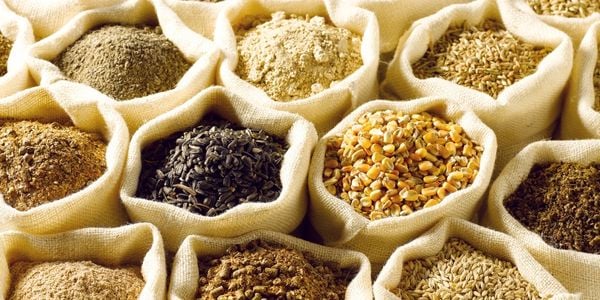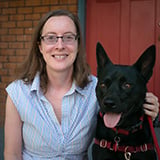
What is the primary purpose of food? I think most of us would agree that its main purpose, even though there are others, is to provide the body with the essential nutrients for growth, repair, and maintenance.
Essential nutrients include proteins, fats, carbohydrates, minerals, vitamins, and water. All of which are vital to helping the body function properly.
When the body does not receive an adequate amount of a particular nutrient, it is at an increased risk of developing a disease or illness.
While grain-free diets are very common and some of the most expensive dog food brands on the market, it doesn't mean they are nutritious for your dog. There are many things to consider in assessing whether the grain-free diet you're feeding your dog is beneficial. Many could be harmful. Read on to learn more, and let me know if you have any questions at the end of this article.
Dogs Are Not People
While this may seem obvious, it seems to be forgotten when it comes to feeding our pets. We often want to feed them what we feed ourselves, forgetting their nutritional needs are different.
There are a lot of different diet plans people follow for different reasons. And we assume because those diet plans work for us, they will benefit our dogs. Well, not always.
Back in 2007, there was a gamut of recalls of pet foods produced from products, such as wheat gluten, corn gluten, and rice protein concentrates, that came from China containing melamine (an industrial product). Those foods were recalled because pets were suffering from severe health issues after consuming them.
Additionally, at that time, the trend in human diets was starting to move away from grains and gluten-containing foods.
It was during this time that grain-free and other types of diets increased in popularity, and many pet owners transitioned their dogs to these types of diets since they were marketed as being better for gluten sensitivities, loaded with exotic proteins and legumes, more closely resembled dog’s ancestral diets and overall healthier for dogs.
Just like not all diet trends for people are beneficial, the same applies to our furry friends.
Diets, including boutique, exotic ingredient, and grain free, are referred to as ‘BEG’ diets.
Some Grain-Free Truths & Myths
Grain-free diets represent more than 40% of available dry dog food in the United States. In fact, in the USA, from 2012 to 2016, sales increased 221%.
When dog food is labeled as grain-free, it is made without the following ingredients:
- Wheat
- Corn
- Rice
- Soy
- Oats
- Barley
- Rye
Carb replacements: Since dogs still need carbohydrates for energy, these ingredients are replaced with potatoes (white and sweet) in various forms and/or legumes (peas, beans, lentils, chickpeas, or other legume seed pulses).
Gluten sensitivities: Grain-free diets are often marketed as better for dogs with gluten sensitivities. The fact is that while wheat allergies do exist in dogs, they are uncommon. They equate to about 1 in 10,000 in the whole dog population.
Other sensitivities: Grain-free diets are touted as better for dogs with food hypersensitivities to ingredients such as corn, barley, rice, rye, or oats. But just like wheat allergies, these sensitivities are uncommon.
No 'fillers': There is also the claim that grain-free diets are healthier because ‘fillers’ are removed. Valuable nutrients such as vitamins, minerals, essential fatty acids, and fiber are all provided by whole grains, aka ‘fillers.’
Low carbohydrates: Low-carb diets were trendy for human weight loss in the late 1990s and early 2000s. The assumption by many pet owners is that grain-free diets are low-carb. The truth is that alternative carbohydrate sources (potatoes, lentils, chickpeas, and peas) are potentially higher in carbohydrates and can result in weight gain. Additionally, these alternatives may provide fewer nutrients and fiber as compared to whole grains but at a higher cost.
The grain-free diets that are lower in carbs can be higher in both fat and calories. This can lead to weight gain, which is less than ideal for dogs with a history of pancreatitis or hyperlipemia (fatty blood).
Dogs are omnivores: Dogs are viewed as carnivores when in fact, they are omnivores. This means they eat (and need) a diet of both meat and plants. This misunderstanding is why many pet owners think grains are hard for their dogs to digest. The good news is that most dogs digest and use the nutrients from those grains very efficiently (more than 90% of dogs). Additionally, protein can be provided by some grain products that are easier for some dogs to digest than the protein obtained from meat.
The alternative sources of carbohydrates are not necessarily better. And they may cause more harm than just tummy issues.
Quality control: Lastly, quality control and nutritional expertise are not the same among all pet food manufacturers. These variations can result in some potential health issues for dogs. This is especially true for dogs with food allergies because there is no regulation preventing cross-contamination of different food protein allergens on manufacturing lines.
Are Grain-Free (BEG) Diets Healthy or Harmful for Dogs?
There appears to be a connection with all diets under the ‘BEG’ diet classification – boutique, exotic ingredients, and grain free- to diet-associated dilated cardiomyopathy in dogs.
Dilated Cardiomyopathy (DCM)
DCM is characterized by a distention and thinning out of the muscular walls of the heart, causing it to be a less effective pump to move blood throughout the body. As you might imagine, that’s not a good thing! Dogs with DCM are at great risk of progressing to heart failure. You can learn more about the condition in this article from the cardiology department at the Washington State University College of Veterinary Medicine.
To give you a little history, an investigation was begun by the FDA in 2018 after reports of dogs (including breeds without previous known genetic predisposition) developing DCM after consuming diets labeled as grain-free. These diets had as their main ingredients (within the top 10 ingredients listed) peas, lentils, other legume seeds (pulses), and/or potatoes in different forms.
Of the 515 reports of DCM the FDA received between Jan. 1, 2014, to April 30, 2019, the FDA discovered that 90% of those dogs were on grain-free food and 93% were on diets that contained peas and/or lentils. No significant abnormalities were discovered with regard to minerals, metals, and amino acids. By November 1, 2022, the FDA had received 1,382 reports of DCM in dogs.
What Is the Cause of Diet-Associated DCM?
Unfortunately, for the vast majority of cases, the exact cause is unknown. But what has been determined is that the cause is scientifically complex and involves multiple factors.
Consider that for many years, our pets had eaten similar foods – chicken or beef with grains, so their digestibility was known. Scientists are considering whether grain alternatives or unusual meats changed the digestibility of the macro- and micronutrients that affect the heart. Multiple studies have been performed and are still ongoing, researching whether individual grains or proteins are associated with changes in heart function, digestibility, and absorption of individual nutrients.
Some of the links between BEG diets and DCM that have been discovered so far:
Low taurine levels: Low taurine levels were seen in one study1 of Golden Retrievers, but low taurine levels have not been seen in other breeds or been replicated in other studies. One theory is that the legumes interfere with a dog’s ability to absorb taurine from the diet. This hypothesis is not yet proven but continues to be researched. In those cases, improvement occurred with a change in diet and taurine supplementation.
Lower levels of vitamin B: Research findings noted diets associated with DCM had lower volumes of B vitamins. B vitamins are an essential part of the reactions associated with cardiac metabolism.
High concentration of amino acids: Amino acids, amino acids derivatives, and plant-derived compounds, which have been found to contribute to deficiencies in molecules critical to heart function, were found in higher concentrations in DCM-associated diets.
Peas as main ingredient: Reports also indicate that diets containing peas as a main ingredient showed the "greatest association with higher concentrations of compounds in DCM-associated diets.”

What to Do If You Feed Your Dog a Grain-Free Diet?
If you feed your dog a grain-free diet, especially if it's a food that contains peas, chickpeas, lentils, or potatoes in place of the grains, I would STRONGLY suggest that you read about the possible link between feeding a BEG diet and the development of Dilated Cardiomyopathy (DCM), a very serious form of heart disease in dogs.
Additionally, read the following articles:
- FDA press release
- Petfoodology blog by the board-certified veterinary nutritionists at Tufts University School of Veterinary Medicine
- Boutique diets and heart disease by Washington State University College of Veterinary Medicine
- AAHA article on new clues to diet-associated DCM in dogs
Some Other Things You Should Consider Doing
Veterinary Exam
If you’ve switched your dog to a grain-free diet within the past 6 months and your dog hasn’t had a visit and physical exam with your vet since starting the grain-free diet, it’s a good idea to have your dog checked out so your vet can, amongst other things, listen to your dog’s heart and see if any new murmurs have developed.
A heart murmur is often heard in dogs with DCM. (Note that a heart murmur in a dog can be caused by a variety of factors and conditions, not just DCM.)
If your dog hasn’t had a checkup with your vet within the past 12 months, regardless of how long they've been eating a grain-free diet, it’s a good idea to get one on the schedule so that your vet can do a thorough physical examination of your dog, including listening to their heart for murmurs or other abnormalities, such as arrhythmias (abnormal heart rhythm).
Learn how to check your dog's heart rate (pulse) and breathing rate (effort). A rapid heart rate and breathing rate, even at rest, are common signs that dogs in heart failure will exhibit. See the video below or ask your veterinarian or one of their nurses to show you. Getting comfortable with these procedures now will help you learn what’s normal for your dog so that you’ll be better able to know if it becomes abnormal later. You can also learn more about the signs of heart failure in dogs in this article from the cardiology department at Tufts University School of Veterinary Medicine.
Pro-BNP Hormone Level Check
If your dog has eaten a grain-free diet, have your vet check your dog’s Pro-BNP level. This marker shows whether the heart muscle has stretched beyond normal levels. If the level is elevated, your veterinarian will recommend an echocardiogram and an ultrasound of the heart to look specifically at the heart’s size and function.

Consider Changing Foods
Until such time that a potential link between feeding grain-free and DCM is disproven, consider switching your dog to a more traditional, grain-containing diet. The Tufts University HeartSmart Nutrition Service recommends that in addition to using diets containing grains, pet parents avoid diets with peas, lentils, and chickpeas/garbanzo beans in the top 10 ingredients. HeartSmart also recommends avoiding raw, vegetarian, or vegan diets and using diets containing common meats such as chicken and beef rather than more exotic meats such as kangaroo, alligator, and venison. We have less data on how pets digest exotic meats. Until we know more, we must assume this mystery digestibility could play a role in the development of DCM.
Many of the cases in the FDA report improved their heart health and function with treatment, including a transition to a grain-containing diet.
When you are trying to decide what diet is best for your dog, I would recommend consulting with your veterinarian (they know your dog’s medical history) or a veterinary nutritionist.
This article will help guide you on what questions are important to be asking when selecting your dog’s food. And don’t forget that diet transitions should ideally be done gradually.
KetoNatural Pet Foods Lawsuit
On February 6, 2024, KetoNatural Pet Foods filed a class action lawsuit against Colgate-Palmolive, a subsidiary of Hill’s Pet Nutrition, Morris Animal Foundation, Mark Morris Institute, and veterinarians researching diet-related dilated cardiomyopathy’s cause and treatment. KetoNatural Pet Foods believes that Hill’s Pet Food, the academic veterinarians, and the organizations worked together to “promote the false idea that ‘non-traditional’ dog foods raise the risk of DCM.” Hill’s has not yet responded to this lawsuit.

I have seen pets with diet-related DCM, and the anguish of their families who thought they had chosen a healthy diet. If I could offer KetoNatural Pet Foods some advice, I would recommend that they include their food in the ongoing DCM studies to see whether it is safe for dogs rather than spend their money on a lawsuit.




